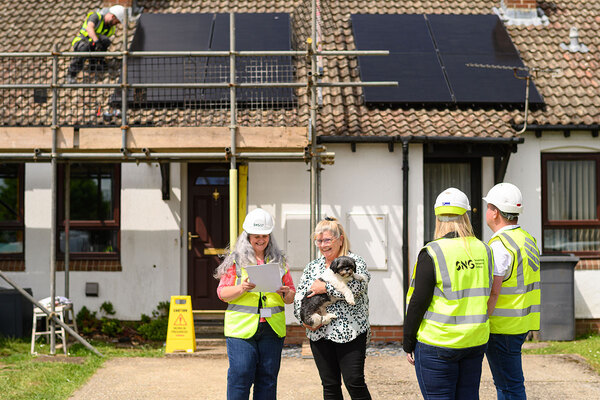You are viewing 1 of your 1 free articles
The man with a mission to change major works at L&Q
Mark Newstead was hired to shake up L&Q’s major repairs programme. Jess McCabe finds out how he plans to go about it. Photography by Sam Mellish
Running the asset management programme of a social landlord arguably used to be one of the less high-profile jobs in the sector. That has profoundly changed.
Landlords face a significant programme of work to retrofit homes to make them cheaper to heat and more comfortable to live in, to cut emissions and curb rising energy bills. And then there is the disrepair scandal where tenants have been left in homes plagued by damp, mould and other problems.
L&Q – being one of the largest landlords in the country – has been caught up in this along with many others. Partly in response, it has more than doubled spending on major repairs, from £34m to £71m in 2021-22. It expects to spend about £90m this year.
At the time, the landlord said this was to allow “more focus on and investment in the safety of our residents and colleagues, to increase investment in residents’ homes and to focus on delivering reliable, repeatable and consistent service”.
It also hired Mark Newstead to head up this work as director of major works, as part of an overhaul of how the 110,000-home landlord tackles repairs and maintenance.
Tackling the big issues
Inside Housing caught up with Mr Newstead a few months into the job, to find out what changes he is making – and how the landlord will manage to improve its asset management approach in a time of inflation, labour shortages and a looming rent cap.
Mr Newstead sums up the reasons he was hired (see more in the box below). “L&Q has decided to put much more investment into homes, and to have a completely new approach to major works. And so my appointment was part of that transformation,” he says.
To go back to why that investment and new approach are necessary, we have to talk about disrepair.
In 2021, ITV News broadcast the horrifying story of Junior Jimoh breathing with the assistance of a ventilator in his L&Q flat in Clapham, south London. The flat was covered in damp and black mould. Mr Jimoh was moved to a new home after the story was broadcast and Fiona Fletcher-Smith, chief executive at L&Q, said: “To make sure that a similar case cannot happen again, we have shared Mr Jimoh’s story with all of our colleagues and have made a number of changes to ensure that residents’ voices are always heard, and that safety and quality issues are addressed.”
L&Q is far from the only landlord that has found itself in the national news over egregious disrepair impacting tenants. The stories uncovered in the national press and on social media have gone far and wide throughout the sector.
An inquest concluded this month after the death of a two-year-old boy, Awaab Ishak. The inquest concluded the death was directly linked to mould in a Rochdale Boroughwide Housing (RBH) flat.
Gareth Swarbrick, then-chief executive at RBH before he was later sacked, said: “We didn’t recognise the level of risk to a little boy’s health from the mould in the family’s home. We allowed a legal disrepair process, widely used in the sector, to get in the way of promptly tackling the mould.”
He added: “We must make sure this can never happen again. Awaab’s death needs to be a wake-up call for everyone in housing, social care and health.”
One factor that has repeatedly come up in disrepair scandals is landlords not being on top of the extent of disrepair problems. So it is not surprising that Mr Newstead is keen to emphasise the efforts L&Q is going to in filling those knowledge gaps.
L&Q is carrying out between 13,000 and 14,000 stock condition surveys this year. “We want to be doing 20% of our stock every year, so that nowhere do we have a stock survey more than five years old,” Mr Newstead says.
He talks in terms of disrepair complaints, reports from housing officers and information from L&Q’s response repairs teams as being “business intelligence”. There is also talk of co-designing services with residents. “We keep saying to people, whether that’s our contractors or staff, it’s not just about the end product and delivery, it’s about the resident experience of how we get there,” he says.
“L&Q has decided to put much more investment into homes, and to have a completely new approach to major works”
Is this a real shift in how the landlord is approaching investment in its properties? It is hard to tell from any interview – but money talks.
L&Q has not settled on a final figure for investment in planned works for the next financial year – like other social landlords, it is waiting to find out what the rent cap for English landlords is going to be. But Mr Newstead says the figure will rise again regardless from this year’s spending – which he puts at around £90m. “We don’t yet have the final investment, but it will be substantially more than the £90m” that it is spending this year.
If the government opts to cap social housing rents at the lower end of the proposals (the options are 3%, 5% and 7%), there is clearly going to be some impact on how much L&Q can invest in homes. But Mr Newstead says: “We will do less work than we wanted to, but we will still do more work than we were doing.”
This is not just driven by disrepair issues. There is fire safety work, although Mr Newstead describes this as “sizable, but not the majority of what we’re doing within our programme”.
And then there is zero carbon. Mr Newstead says that only 20,000 homes out of L&Q’s 110,000 properties need upgrading to get them to Energy Performance Certificate Band C by 2030. The landlord is also aiming for carbon neutrality by 2050.
Mark Newstead’s journey so far
Mark Newstead has worked in social housing since he left university – his first job was as an area surveyor for Peterborough housing association, Axiom.
“I grew up in a council house, not far away in Huntingdon. Being able to go to work in social housing and to improve homes, that was quite attractive, coming out of university, getting that opportunity,” he says.
Working in housing has run in the family – Mr Newstead’s father was a builder and his grandfather was a carpenter. His wife works in development for Clarion, while his eldest child is a quantity surveyor working mostly on social housing projects. “The youngest one is the dark sheep of the family because she’s studying English at Exeter,” he jokes.
He has had stints across the sector – including being development director at Hanover, working on extra-care developments, and working in organisations such as Sanctuary and Newlon. Prior to joining L&Q, he was director of property services and safety at Lewisham Homes.
One focus of his team will be on delivering those upgrades through work on the fabric of the building – meaning better windows and insulation. “Making people’s homes better insulated has a big impact on people’s heating bills,” Mr Newstead notes. The landlord is planning a “substantial” bid to the Social Housing Decarbonisation Fund to help fund this.
“It helps combat damp and mould as well, which is obviously something we’re very aware of,” he adds.
“You can have issues around people not putting the heating on, overcrowding in properties – all of those things can contribute to damp and mould. So, it’s a complicated picture,” he says. But he adds: “There can be no blaming of residents for this, the resident didn’t choose to have this problem. But whatever the source of the problem, we have to be able to work with the resident to alleviate that. And if asked about repairs, or investment, fine. If it’s about other things around not being able to afford to put the heating on, then we’ve got to work with them around benefits, around efficiency of the property and other things to make sure that we’re helping them with that problem.”
Mr Newstead says that his team is doubling in size to cope with this work, and that L&Q is in the middle of a procurement process for up to 30 new contractors. Unusually for the sector, these new contracts will be 15 years in length. “They’re very, very long-term agreements. Hundreds of millions, billions [of pounds] even, through that period of time.”
Preparing the budget
By doing this, L&Q is hoping to combat the quality and supply issues that come with the regular round of budget-setting and planning with repairs and maintenance contractors on either year-to-year contracts, or at most a “five-plus-five” year agreement.
It is typical in the sector, Mr Newstead says, for contractors to find “the budget would get set quite late”, resulting in work starting “later than they would want, then they will be struggling through the back end of the year to deliver all of the work that they wanted to do”.
“If you say that to any surveyor or person working in planned works, that will be a very familiar scenario. We wanted very much to move away from that,” he explains.
“We’ve seen failures of big contractors in the past, it’s highly disruptive to us and to our residents. So it’s in our interest that contractors are viable”
These contracts will be “open-book” contracts, with generic target costs set across all the contractors. “No model can completely protect you from rises in the cost and issues in the economy,” he says. “And, actually, if it did, it would probably do that to the detriment of the contractor. And it’s not in our interests, or any clients’ interests, to force contractors to work for unaffordable and unviable rates because they will go out of business.
“We’ve seen failures of big contractors in the past, it’s highly disruptive to us and to our residents. So it’s in our interest that contractors are viable. But clearly, we do not want to be paying more than we have to be paying – it has to be a fair market rate based on the cost,” he adds.
That is a difficult balance to maintain – particularly with inflation at about 10%. But L&Q hopes that longer contracts, with more certainty, will help with securing sub-contractors and labour. These smaller businesses, which often end up actually carrying out the work, “need continuity of work, they need to get paid on time. They need support. And they can only get that support from the bigger businesses, if the bigger businesses themselves have long-term contracts”.
The landlord also hopes these long-term contracts will allow it to carry out more work at once on homes, guided by all that business intelligence mentioned earlier, rather than the traditional “component-led” approach. The idea is that this should save money and mean less disruption to residents.
The procurement process is still going on, but Mr Newstead says so far “we’ve had a very strong response and bidders coming through to that. So it would seem that the market has responded very positively to the long-term contracts, but on a different model”.
The sector has been criticised for procuring mostly based on price, leading to a race to the bottom. Mr Newstead says that L&Q hopes to rebalance this, with the contracts decided by 65% on quality, 20% on price and 15% on social value.
All of this speaks to an ambition to change how major works are done, and to invest a lot more in properties, and in relationships with contractors, to increase the quality of work being carried out. Will it be a success? The answer to that will be found in whether residents of the landlord see a real improvement.
Sign up for our asset management newsletter
Already have an account? Click here to manage your newsletters












